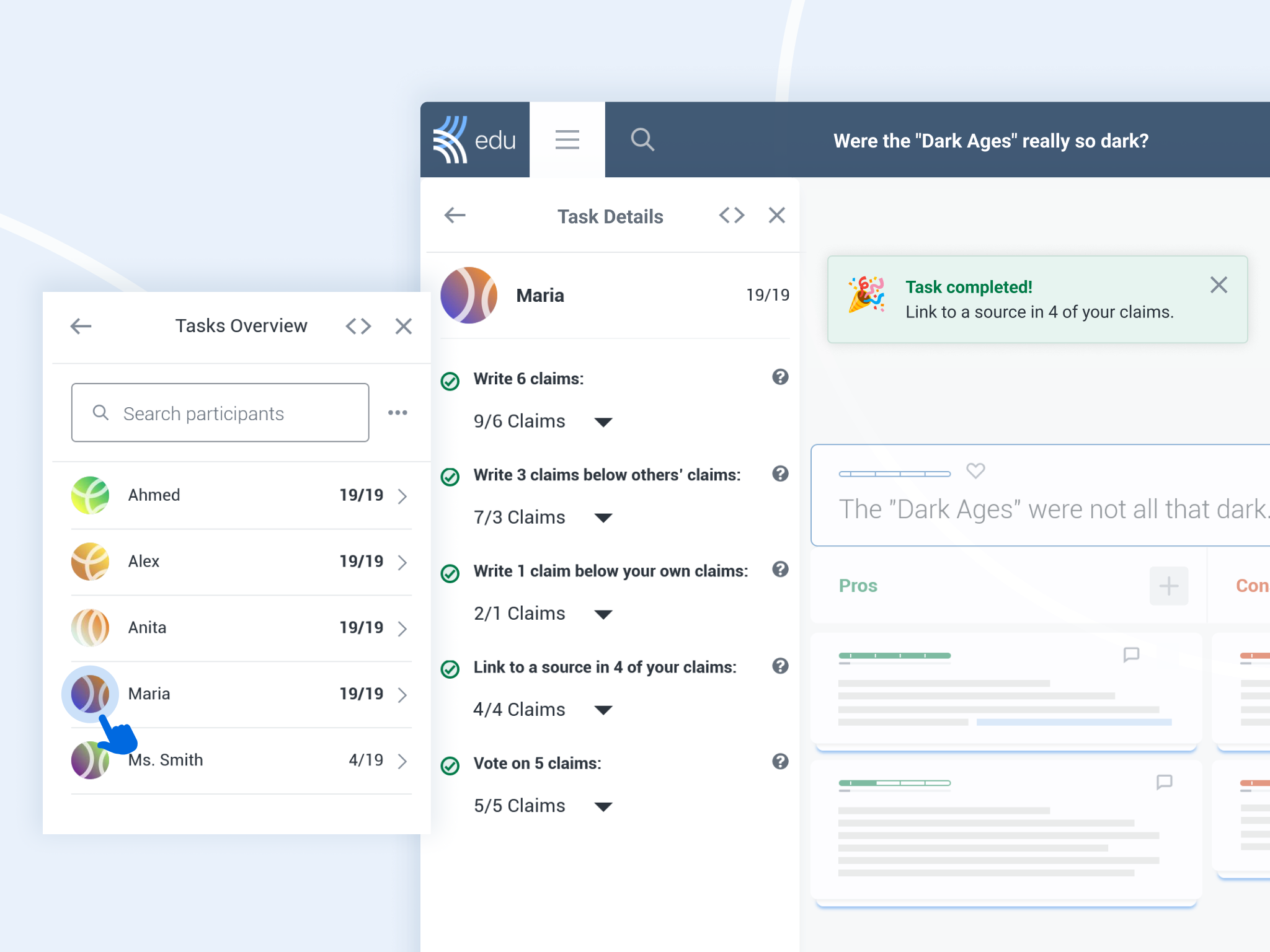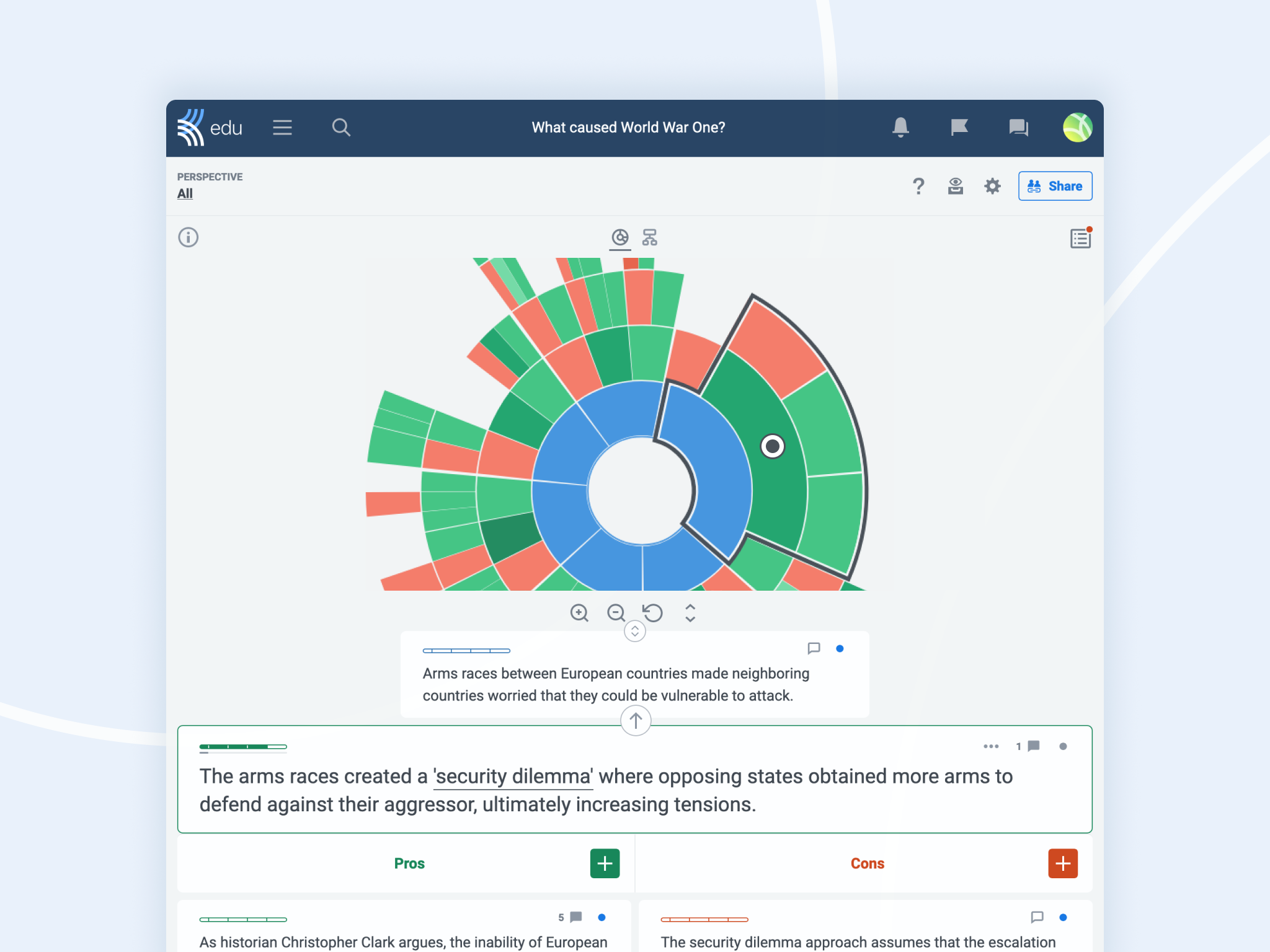In developing persuasive writing skills, students learn to communicate their ideas clearly, convincingly, and ethically, which is important across academic, personal, and professional settings. Students are most likely to practice these skills in persuasive essay writing, where they need to both inform and influence an audience.
To be successful, students need to master the skills of understanding their audience’s perspective, anticipating counterarguments, and building a compelling case. And with so many considerations to bear in mind, it’s essential that students use prewriting to help them in the persuasive writing process!
In this article, we’ll talk about why prewriting is important for persuasive writing, some strategies you can use, and how you can use Kialo Edu as a tool in this process.
Why is prewriting important for writing persuasive essays?
Though it may seem like a drag to students who just want to put pen straight to paper, prewriting is important to ensure students start writing with a clear plan, purpose, and approach.
Giving students strategies to tackle a writing assignment supports metacognitive skills in writing, helping them become better writers in the process. And prewriting can even save them time in the long run, by helping students produce a focused and coherent essay from the start, minimizing the need for extensive revisions.
Prewriting allows students to first generate broad ideas, and to then refine these ideas to bring focus and clarity to their argument. Prewriting also gives students an opportunity to intellectually engage with the topic, making sure important points aren’t overlooked to make sound arguments!
What are some prewriting strategies for persuasive writing?
Here are strategies to help students generate and select ideas, then decide on their position and approach. Students may do all or just some of these!
1. Use brainstorming techniques to generate ideas and identify prior knowledge
Brainstorming encourages a flow of ideas, free from judgment or rigid structure. It helps students identify what they already know about a topic, or provide inspiration when drawing a blank on where to begin. Conversely, it also helps to get ideas down on paper when there are just too many of them floating around.
Brainstorming can take on many forms. It can be done individually as a more reflexive exercise or collaboratively to tap into a group’s different perspectives. It can take different structures, from simple lists to word clouds, or even free writing style exercises.
Try using a Kialo discussion for initial idea generation — set up a discussion on an essay topic, such as whether population decline is a good thing, and ask groups of students to quickly create as many claims as they can based on their existing knowledge and immediate instincts. They can then return to refine it later as they’re working on their essays!
2. Carry out research to understand the issues and lend credibility to arguments
Help students see the value in carrying out appropriate research as a part of prewriting for their persuasive essays. Effective persuasive essays will offer robust arguments while acknowledging and addressing counterpoints. Thus, students need to show that they have a good understanding of the issues and include sources to lend credibility to their writing.
Adding research to their prewriting activities can also help students learn to meet required academic standards in the analysis, evaluation, and synthesis of sources. And, by using research to deepen their understanding of the topic, students can more confidently take a strong position.
Using a Kialo discussion as a prewriting activity on a topic like space exploration allows students to record their research alongside the arguments and details it unveils, with the Sources feature providing a handy reference list. Set a task for a particular number of sources to make research a clear objective for students to meet.

3. Use questioning to explore the topic from different angles

Asking targeted questions throughout the prewriting process helps students explore the topic in-depth and decide on an approach. Encourage students to make detailed use of journalistic questions — Who? What? Where? When? Why? How? — to pull together important elements from different angles. Who questions might seek to identify those most impacted by the topic to look at different perspectives, or the role of key stakeholders. Why questions might prompt students to consider the root causes of the issue or why their argument is important.
Students can use a multi-thesis Kialo discussion, such as this one on the causes of the Great Depression, to explore different answers to a central question in the prewriting process. The multi-thesis discussion can help students identify their strongest arguments, anticipate counterarguments, or simply to have a more thorough understanding of the topic from different angles.
4. Identify audiences to tailor the persuasive message to their beliefs and values
Framing an essay to be meaningful and relevant to the target reader goes a long way toward making it more engaging and persuasive. By taking the time to consider their audience, students can speak directly to reader concerns and interests in an appropriate tone. That may mean identifying the arguments most likely to hit home or the counter-arguments a particular audience is most likely to raise.
A persuasive essay on urban planning, for instance, will seek to persuade residents and local business owners from different angles. In cases where the only stated audience is the educator, speaking to reader interests might include using a suitable writing style or addressing other curricular standards.
5. Organize thoughts and information to create a clear picture of the persuasive essay
Teaching students to externally organize their thought processes and information during prewriting can set them on the smoothest path to producing a well-structured persuasive essay. Some techniques include using mind maps to make sense of brainstormed notes and gathered research, or outlining an essay and creating a paragraph plan to guide the actual writing. You might ask students to talk their plan through with a partner to identify gaps in their arguments and gain insight from another perspective.
A Kialo discussion is an effective way for students to externalize and examine their thinking and gathered information. Students can use Kialo’s branching structure to develop their thoughts in many directions, making it easier to spot connections between ideas.

Meanwhile, the extra input from peers’ supporting and opposing claims helps students refine and select the most convincing arguments to use in their persuasive essays. Because claims in a Kialo discussion are meant to be short, students can focus on their ideas before refining to the most appropriate wording to make their case in the essay.
Learning to influence others’ opinions and advocate for your point of view in written form is a good skill for students to have. We’d love to hear about how you persuade your students to participate in prewriting! Please do get in touch at feedback@kialo-edu.com or any of our social media platforms.

